QUT - PUN620 Presentation: Solid Waste Management Case Study
VerifiedAdded on 2023/06/13
|12
|924
|263
Presentation
AI Summary
This presentation provides an overview of solid waste management, including its meaning, importance, and various methods such as sanitary landfills, incineration, recovery and recycling, composting, and pyrolysis. It highlights the negative effects of poor solid waste management, including pollution, foul odors, disease breeding grounds, and loss of environmental aesthetic value. The presentation emphasizes the importance of appropriate solid waste management for environmental conservation, reducing health problems, and enhancing a clean environment, referencing several studies and research papers to support its points.

Solid Waste
Management.
Student’s Name
Institutional Affiliation
Management.
Student’s Name
Institutional Affiliation
Paraphrase This Document
Need a fresh take? Get an instant paraphrase of this document with our AI Paraphraser
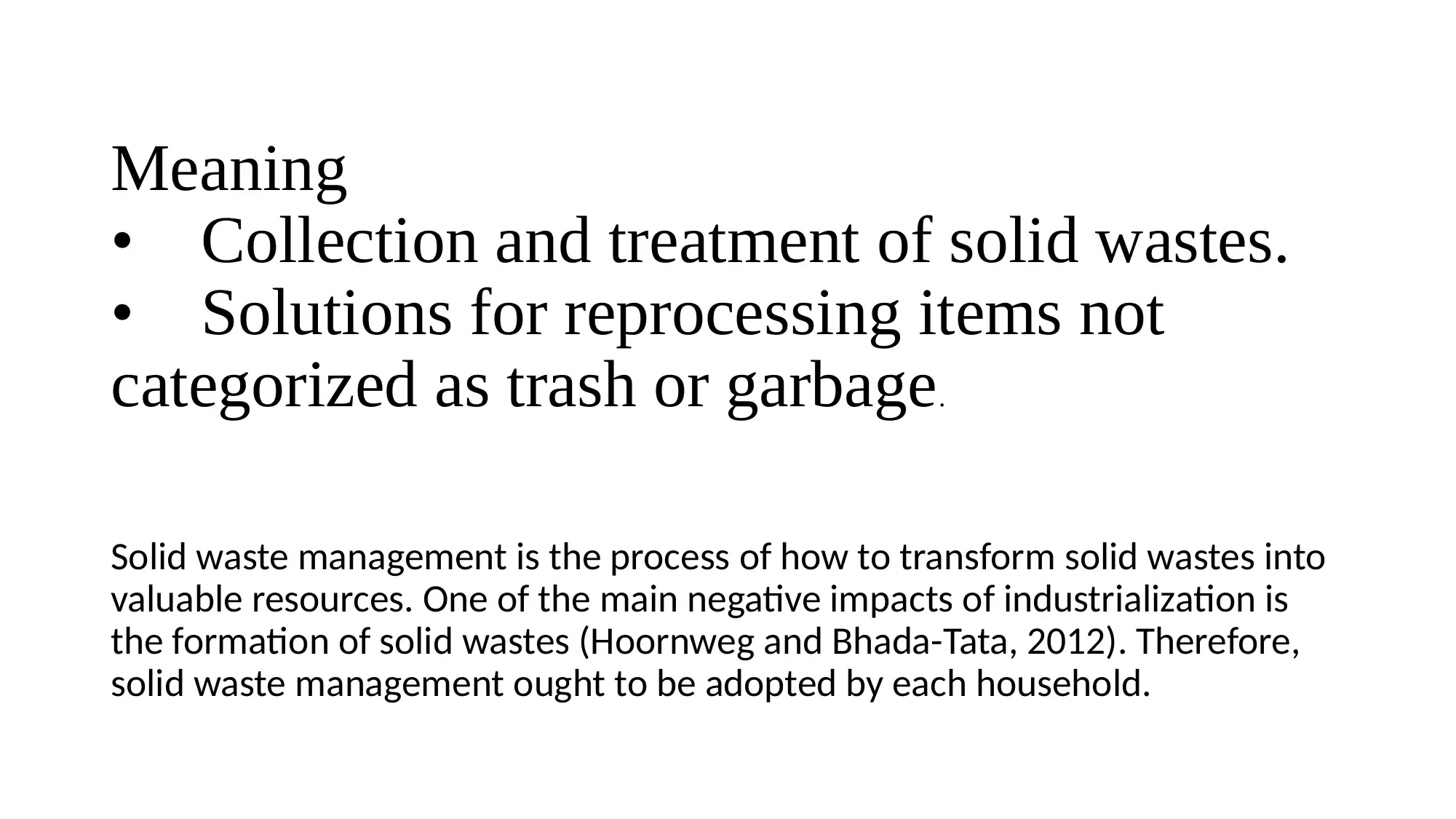
Meaning
• Collection and treatment of solid wastes.
• Solutions for reprocessing items not
categorized as trash or garbage.
Solid waste management is the process of how to transform solid wastes into
valuable resources. One of the main negative impacts of industrialization is
the formation of solid wastes (Hoornweg and Bhada-Tata, 2012). Therefore,
solid waste management ought to be adopted by each household.
• Collection and treatment of solid wastes.
• Solutions for reprocessing items not
categorized as trash or garbage.
Solid waste management is the process of how to transform solid wastes into
valuable resources. One of the main negative impacts of industrialization is
the formation of solid wastes (Hoornweg and Bhada-Tata, 2012). Therefore,
solid waste management ought to be adopted by each household.

Introduction
• Solid waste management involves
the collection, treatment and effective
disposal of solid materials.
• The materials have served their
purpose hence are no longer needed.
The management of solid waste is vital because the materials might
create unsanitary an unhealthy conditions. Consequently, these
conditions can result in environmental pollution or disease outbreaks
more so vector-borne ailments which are spread by insects and
rodents.
• Solid waste management involves
the collection, treatment and effective
disposal of solid materials.
• The materials have served their
purpose hence are no longer needed.
The management of solid waste is vital because the materials might
create unsanitary an unhealthy conditions. Consequently, these
conditions can result in environmental pollution or disease outbreaks
more so vector-borne ailments which are spread by insects and
rodents.
⊘ This is a preview!⊘
Do you want full access?
Subscribe today to unlock all pages.

Trusted by 1+ million students worldwide
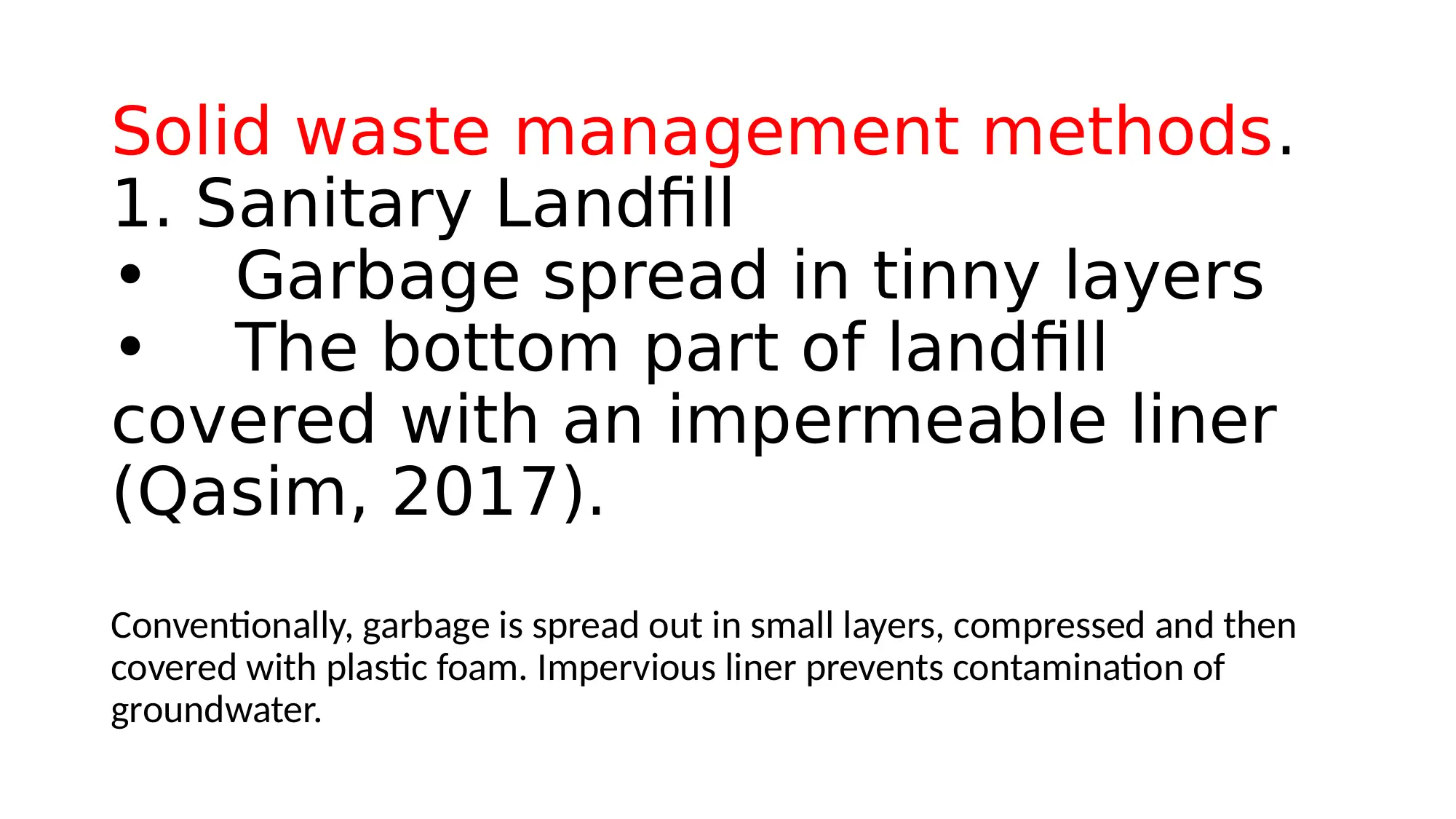
Solid waste management methods.
1. Sanitary Landfill
• Garbage spread in tinny layers
• The bottom part of landfill
covered with an impermeable liner
(Qasim, 2017).
Conventionally, garbage is spread out in small layers, compressed and then
covered with plastic foam. Impervious liner prevents contamination of
groundwater.
1. Sanitary Landfill
• Garbage spread in tinny layers
• The bottom part of landfill
covered with an impermeable liner
(Qasim, 2017).
Conventionally, garbage is spread out in small layers, compressed and then
covered with plastic foam. Impervious liner prevents contamination of
groundwater.
Paraphrase This Document
Need a fresh take? Get an instant paraphrase of this document with our AI Paraphraser
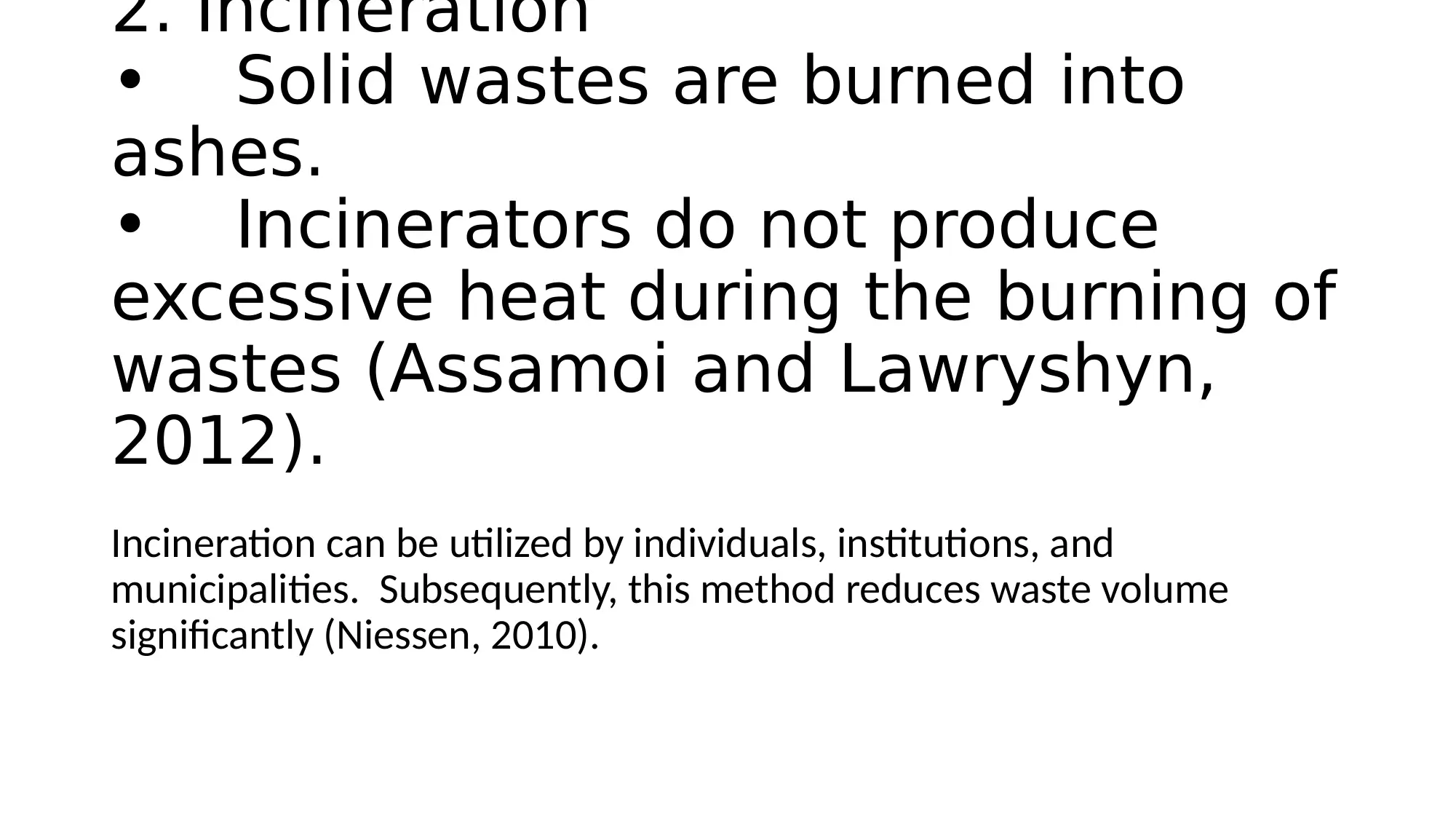
2. Incineration
• Solid wastes are burned into
ashes.
• Incinerators do not produce
excessive heat during the burning of
wastes (Assamoi and Lawryshyn,
2012).
Incineration can be utilized by individuals, institutions, and
municipalities. Subsequently, this method reduces waste volume
significantly (Niessen, 2010).
• Solid wastes are burned into
ashes.
• Incinerators do not produce
excessive heat during the burning of
wastes (Assamoi and Lawryshyn,
2012).
Incineration can be utilized by individuals, institutions, and
municipalities. Subsequently, this method reduces waste volume
significantly (Niessen, 2010).
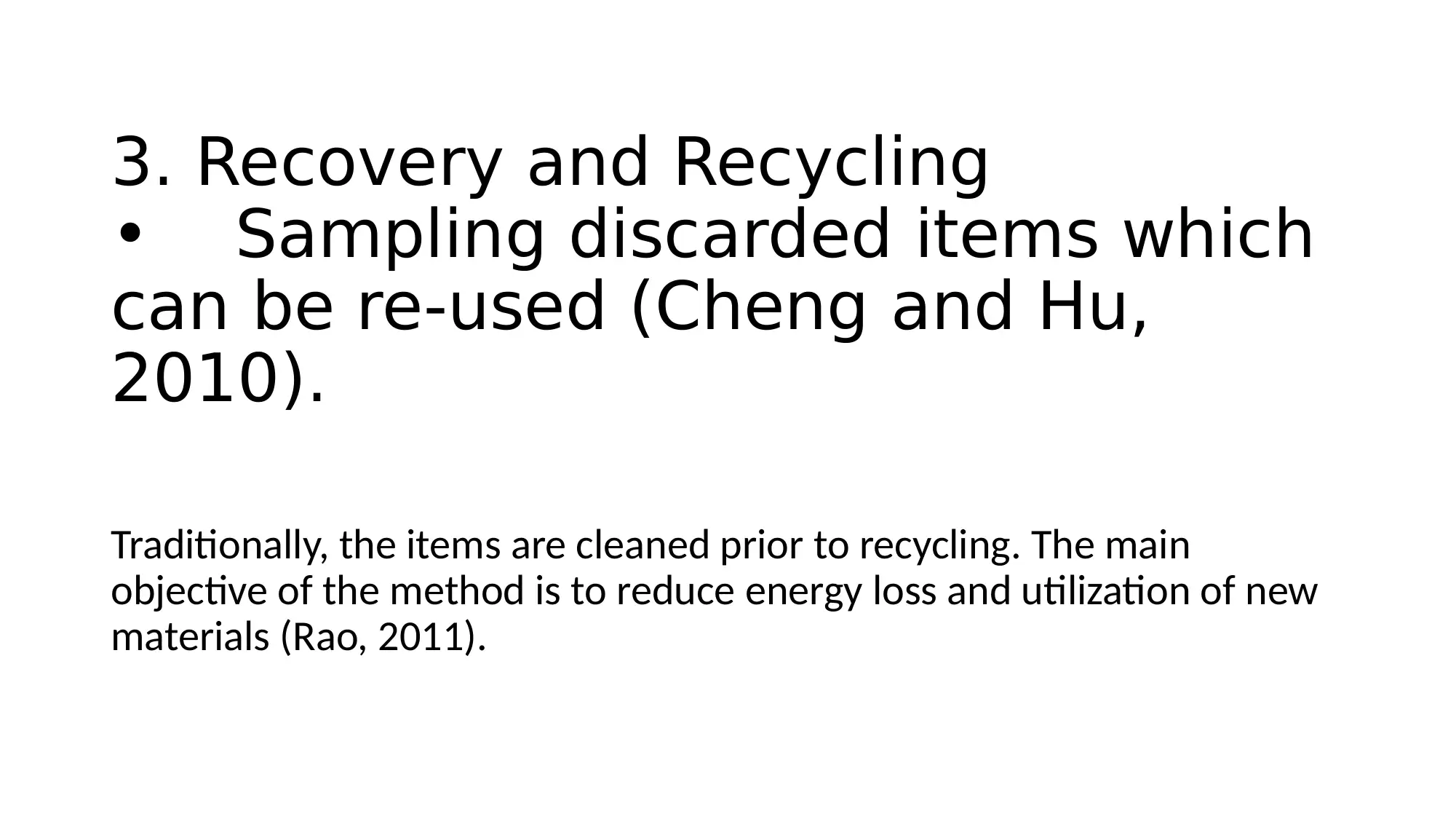
3. Recovery and Recycling
• Sampling discarded items which
can be re-used (Cheng and Hu,
2010).
Traditionally, the items are cleaned prior to recycling. The main
objective of the method is to reduce energy loss and utilization of new
materials (Rao, 2011).
• Sampling discarded items which
can be re-used (Cheng and Hu,
2010).
Traditionally, the items are cleaned prior to recycling. The main
objective of the method is to reduce energy loss and utilization of new
materials (Rao, 2011).
⊘ This is a preview!⊘
Do you want full access?
Subscribe today to unlock all pages.

Trusted by 1+ million students worldwide
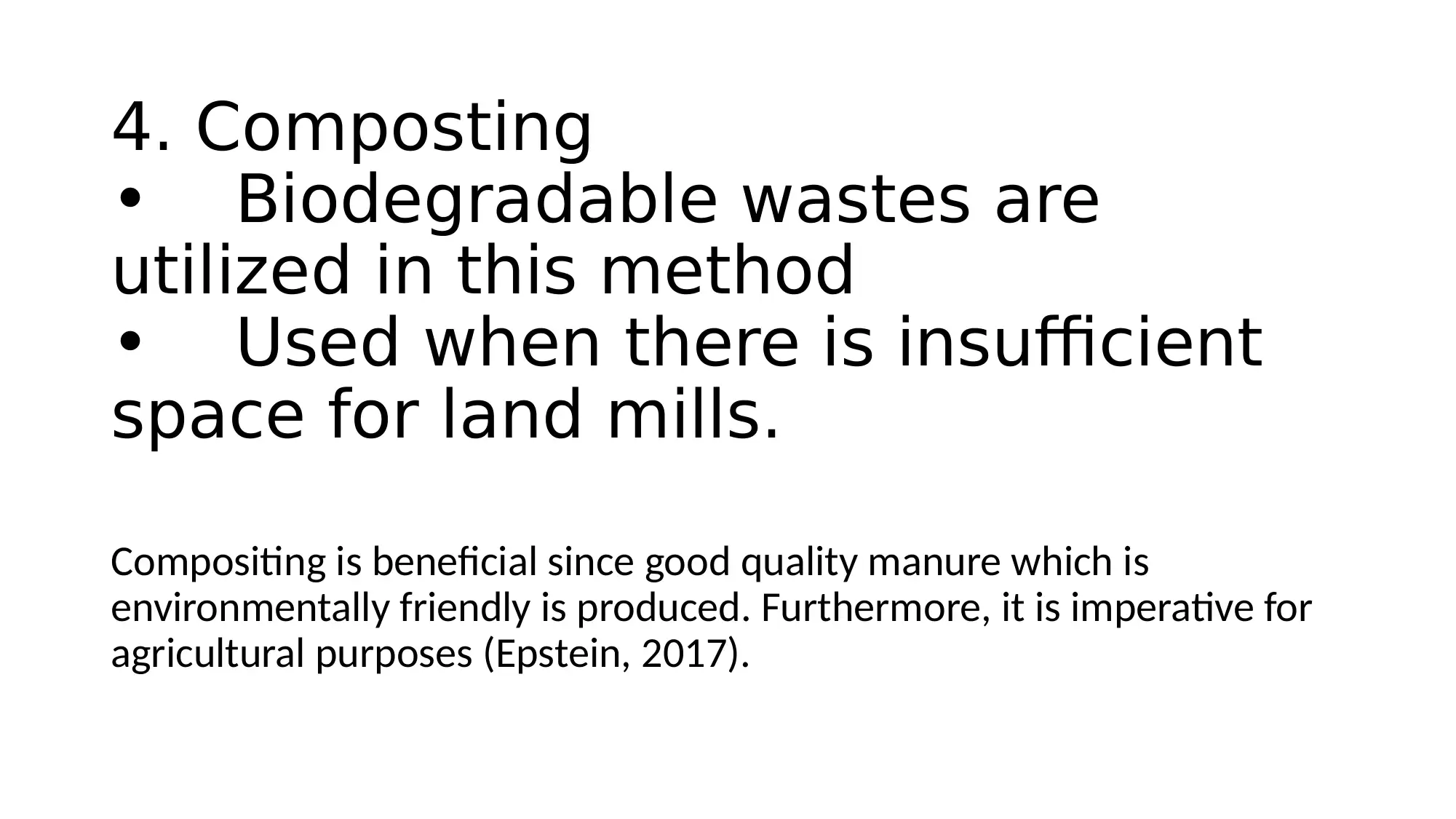
4. Composting
• Biodegradable wastes are
utilized in this method
• Used when there is insufficient
space for land mills.
Compositing is beneficial since good quality manure which is
environmentally friendly is produced. Furthermore, it is imperative for
agricultural purposes (Epstein, 2017).
• Biodegradable wastes are
utilized in this method
• Used when there is insufficient
space for land mills.
Compositing is beneficial since good quality manure which is
environmentally friendly is produced. Furthermore, it is imperative for
agricultural purposes (Epstein, 2017).
Paraphrase This Document
Need a fresh take? Get an instant paraphrase of this document with our AI Paraphraser

5. Pyrolysis
• Solid wastes chemically
decomposed
• Done under high temperature
usually 430 degrees Celsius (Velghe
et al,2011).
Pyrolysis is achievable under high temperatures and pressure.
Moreover, during the process oxygen is absent. Wastes are transformed
into liquid, solid residue and gasses.
• Solid wastes chemically
decomposed
• Done under high temperature
usually 430 degrees Celsius (Velghe
et al,2011).
Pyrolysis is achievable under high temperatures and pressure.
Moreover, during the process oxygen is absent. Wastes are transformed
into liquid, solid residue and gasses.
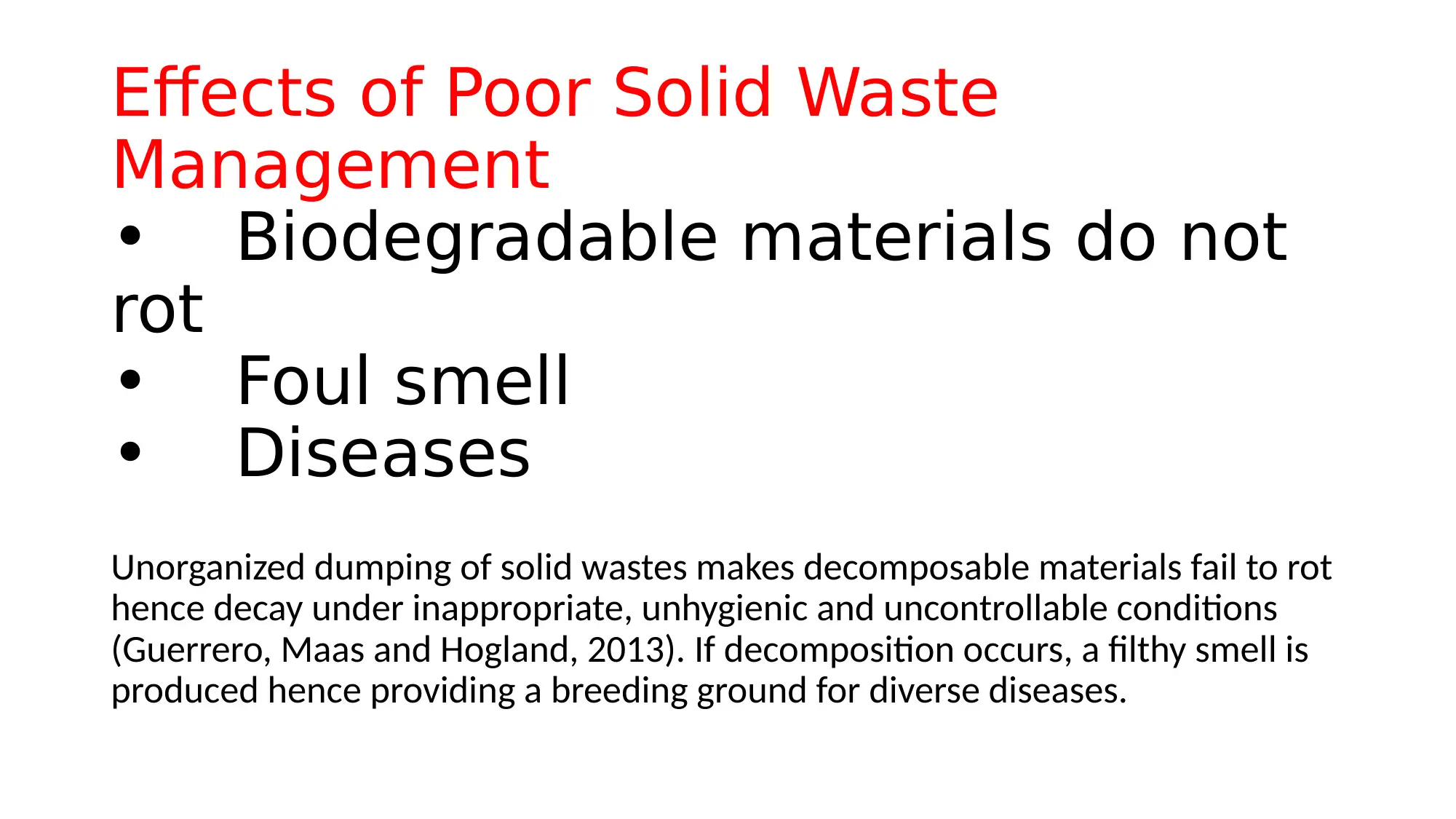
Effects of Poor Solid Waste
Management
• Biodegradable materials do not
rot
• Foul smell
• Diseases
Unorganized dumping of solid wastes makes decomposable materials fail to rot
hence decay under inappropriate, unhygienic and uncontrollable conditions
(Guerrero, Maas and Hogland, 2013). If decomposition occurs, a filthy smell is
produced hence providing a breeding ground for diverse diseases.
Management
• Biodegradable materials do not
rot
• Foul smell
• Diseases
Unorganized dumping of solid wastes makes decomposable materials fail to rot
hence decay under inappropriate, unhygienic and uncontrollable conditions
(Guerrero, Maas and Hogland, 2013). If decomposition occurs, a filthy smell is
produced hence providing a breeding ground for diverse diseases.
⊘ This is a preview!⊘
Do you want full access?
Subscribe today to unlock all pages.

Trusted by 1+ million students worldwide

Effects of Poor Solid Waste
Management
• Pollution of water
• Loss of environment’s aesthetic
value
• Source of toxic chemicals.
• Low soil productivity
Ineffective solid waste management interferes with the environment’s beauty.
Consequently, solid wastes more so from industries are a constant source of other
hazardous wastes, toxic metals, and chemicals (White, Dranke and Hindle, 2012).
These wastes cause physicochemical and biological problems in the soil, therefore,
interfering with its productivity. Likewise, the wastes pollute groundwater.
Management
• Pollution of water
• Loss of environment’s aesthetic
value
• Source of toxic chemicals.
• Low soil productivity
Ineffective solid waste management interferes with the environment’s beauty.
Consequently, solid wastes more so from industries are a constant source of other
hazardous wastes, toxic metals, and chemicals (White, Dranke and Hindle, 2012).
These wastes cause physicochemical and biological problems in the soil, therefore,
interfering with its productivity. Likewise, the wastes pollute groundwater.
Paraphrase This Document
Need a fresh take? Get an instant paraphrase of this document with our AI Paraphraser
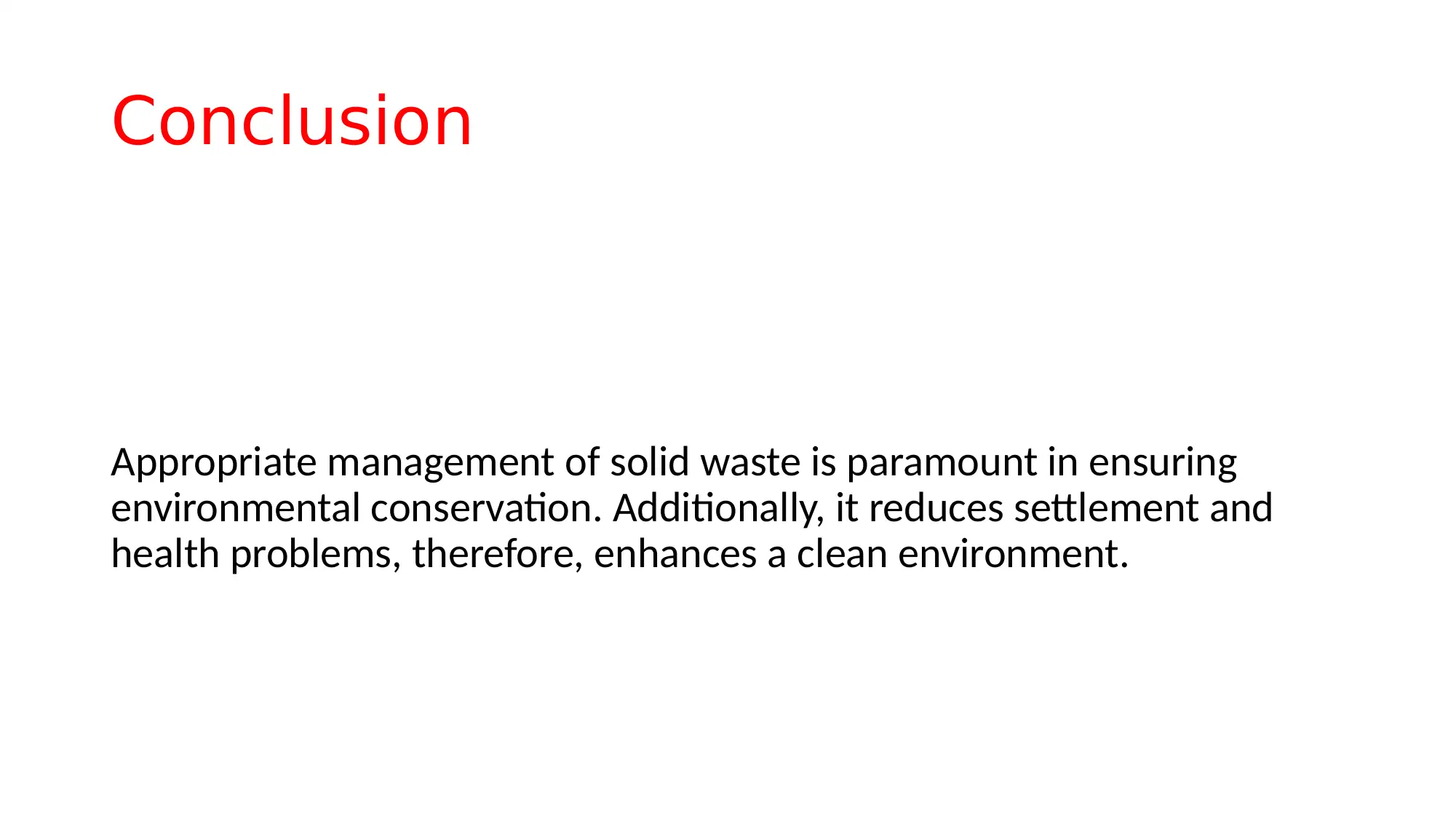
Conclusion
Appropriate management of solid waste is paramount in ensuring
environmental conservation. Additionally, it reduces settlement and
health problems, therefore, enhances a clean environment.
Appropriate management of solid waste is paramount in ensuring
environmental conservation. Additionally, it reduces settlement and
health problems, therefore, enhances a clean environment.
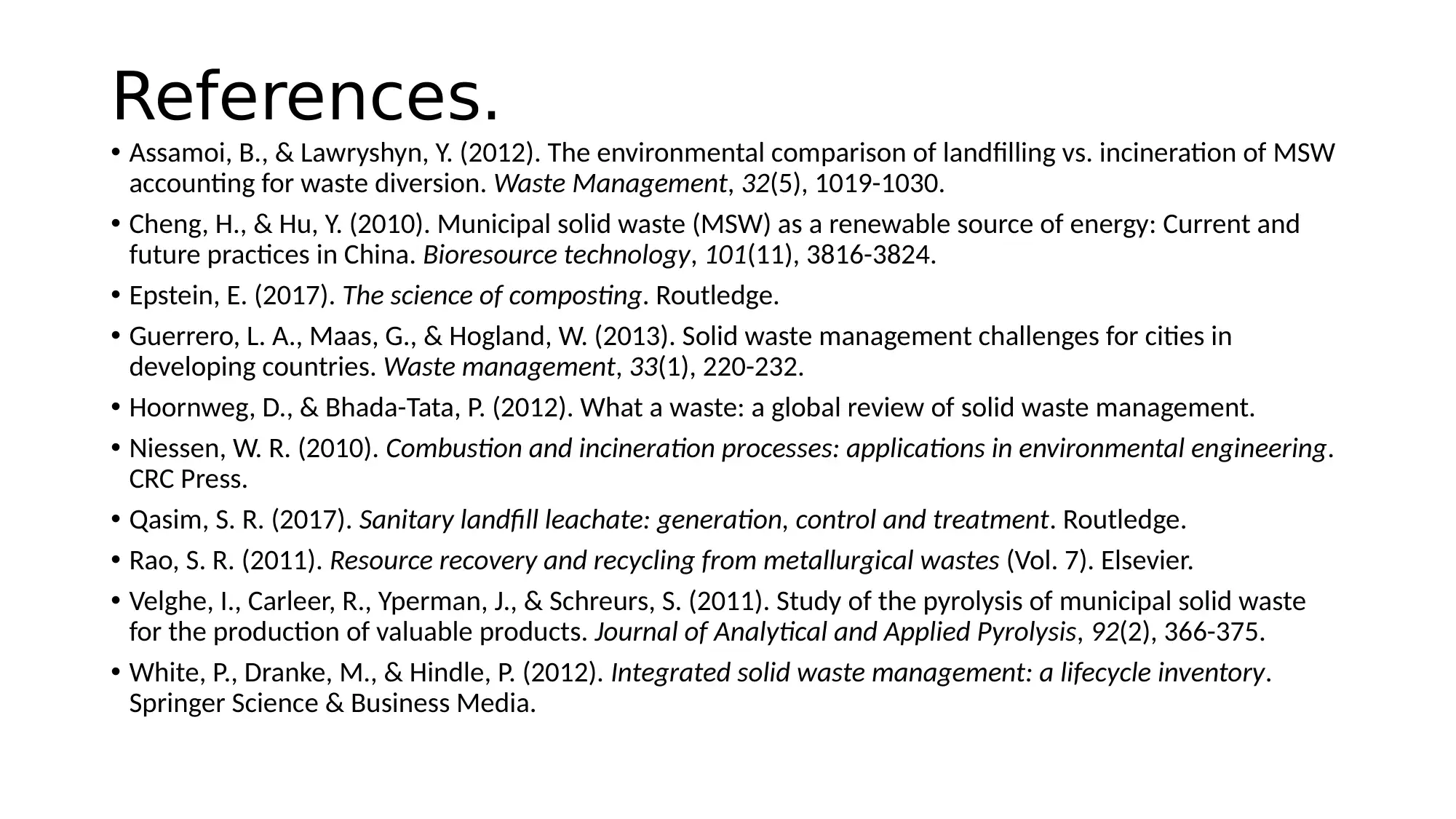
References.
• Assamoi, B., & Lawryshyn, Y. (2012). The environmental comparison of landfilling vs. incineration of MSW
accounting for waste diversion. Waste Management, 32(5), 1019-1030.
• Cheng, H., & Hu, Y. (2010). Municipal solid waste (MSW) as a renewable source of energy: Current and
future practices in China. Bioresource technology, 101(11), 3816-3824.
• Epstein, E. (2017). The science of composting. Routledge.
• Guerrero, L. A., Maas, G., & Hogland, W. (2013). Solid waste management challenges for cities in
developing countries. Waste management, 33(1), 220-232.
• Hoornweg, D., & Bhada-Tata, P. (2012). What a waste: a global review of solid waste management.
• Niessen, W. R. (2010). Combustion and incineration processes: applications in environmental engineering.
CRC Press.
• Qasim, S. R. (2017). Sanitary landfill leachate: generation, control and treatment. Routledge.
• Rao, S. R. (2011). Resource recovery and recycling from metallurgical wastes (Vol. 7). Elsevier.
• Velghe, I., Carleer, R., Yperman, J., & Schreurs, S. (2011). Study of the pyrolysis of municipal solid waste
for the production of valuable products. Journal of Analytical and Applied Pyrolysis, 92(2), 366-375.
• White, P., Dranke, M., & Hindle, P. (2012). Integrated solid waste management: a lifecycle inventory.
Springer Science & Business Media.
• Assamoi, B., & Lawryshyn, Y. (2012). The environmental comparison of landfilling vs. incineration of MSW
accounting for waste diversion. Waste Management, 32(5), 1019-1030.
• Cheng, H., & Hu, Y. (2010). Municipal solid waste (MSW) as a renewable source of energy: Current and
future practices in China. Bioresource technology, 101(11), 3816-3824.
• Epstein, E. (2017). The science of composting. Routledge.
• Guerrero, L. A., Maas, G., & Hogland, W. (2013). Solid waste management challenges for cities in
developing countries. Waste management, 33(1), 220-232.
• Hoornweg, D., & Bhada-Tata, P. (2012). What a waste: a global review of solid waste management.
• Niessen, W. R. (2010). Combustion and incineration processes: applications in environmental engineering.
CRC Press.
• Qasim, S. R. (2017). Sanitary landfill leachate: generation, control and treatment. Routledge.
• Rao, S. R. (2011). Resource recovery and recycling from metallurgical wastes (Vol. 7). Elsevier.
• Velghe, I., Carleer, R., Yperman, J., & Schreurs, S. (2011). Study of the pyrolysis of municipal solid waste
for the production of valuable products. Journal of Analytical and Applied Pyrolysis, 92(2), 366-375.
• White, P., Dranke, M., & Hindle, P. (2012). Integrated solid waste management: a lifecycle inventory.
Springer Science & Business Media.
⊘ This is a preview!⊘
Do you want full access?
Subscribe today to unlock all pages.

Trusted by 1+ million students worldwide
1 out of 12
Your All-in-One AI-Powered Toolkit for Academic Success.
+13062052269
info@desklib.com
Available 24*7 on WhatsApp / Email
![[object Object]](/_next/static/media/star-bottom.7253800d.svg)
Unlock your academic potential
Copyright © 2020–2025 A2Z Services. All Rights Reserved. Developed and managed by ZUCOL.
